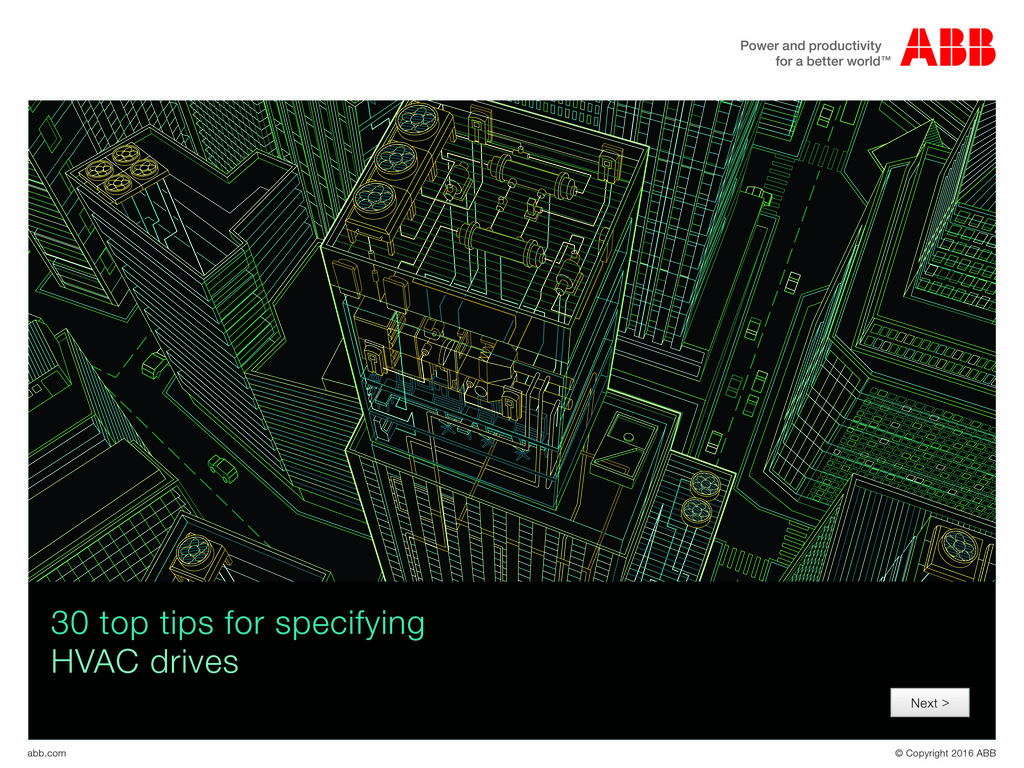

|
Edward Lowton
Editor |


|
| Home> | Plant, Process & Control | >Motors and drives | >30 technical challenges facing users of VSDs in HVAC applications |
| Home> | Energy Management | >Motors and drives | >30 technical challenges facing users of VSDs in HVAC applications |
30 technical challenges facing users of VSDs in HVAC applications
26 July 2016
ABB has identified some 30 technical challenges facing users of variable-speed drives (VSD) within the building services sector and plans over the coming months to target the relevant challenges to each customer type, before collating all 30 by way of a top tips eBook.

The identified challenges are the results of over two decades of VSD installations throughout the building services sector. They are based on feedback from customers, observations of third-party installations and changes to legislations, regulations and standards.
“What has become clear is that not all drives are the same,” explains ABB’s UK manager for HVAC drives, Carl Turbitt. “This is partly due to advances in hardware and software which means that today’s drives are very different to those that were written into specifications several years ago.”
For instance, today’s heating, ventilation and air conditioning (HVAC) applications can be driven with a variety of motor types from electronically commutated motors (ECMs), permanent magnet motors (PM), synchronous reluctance motors (SynRM) and induction motors. Yet users need to be extremely careful when selecting which type of motor can be used for their application.
ECMs, for example, are brushless DC motors that function using a built-in inverter and a magnetic rotor, and as a result are claimed to achieve greater efficiency in air-flow systems than other kinds of AC motors. The motors have a long life and are extremely quiet. However, they can be costly to buy and while the high efficiency offered by ECMs may be suitable for some applications, it is essential that the right motor technology is selected if unforeseen problems with harmonics, catching spinning loads and power loss ride through are to be avoided.
The cost-effective SynRM, for example, offers the same efficiencies as ECMs but without the aforementioned issues. A SynRM controlled properly in a well-designed system can achieve the specific fan powers, whilst being controlled by a traditional VSD that then brings all of the advantages associated with that drive such as: improved harmonic mitigation, adequate power drip ride through, fieldbus connectivity and built-in control features to enhance the application.
“ECMs, at smaller ratings, are more compact and their efficiencies make them attractive to OEMs,” notes Turbitt. “But above 11kW, they are too big to fit fans. Also at higher powers, heat losses cannot be easily dissipated within a fan’s hub design. By contrast, using a VSD and motor package in these higher powers avoids these issues and brings a host of other important benefits such as harmonic mitigation, the ability to catch a spinning load etc.”
Among some of the other considerations when selecting a drive is that not all harmonic mitigation is the same, not all drives are right for outdoor use and not all drives achieve the EMC regulations when connected to a motor.
ABB has addressed many of these challenges by incorporating hardware and software changes in its new ABB HVAC drive, ACH580 - a variable-speed drive dedicated to the HVAC sector.
- Smart sensors change the pace of bearings maintenance
- ABB introduces Condition-Based Maintenance service for robot assessments
- Guide to temperature measurement
- New safety PLC
- Team effort
- Collaborating on ESDV integration
- Robust combustion gas analyser
- Motor & drive packages
- Spherical roller bearings designed to cut installation time
- Higher throughput and lower energy use with motor-drive package

















